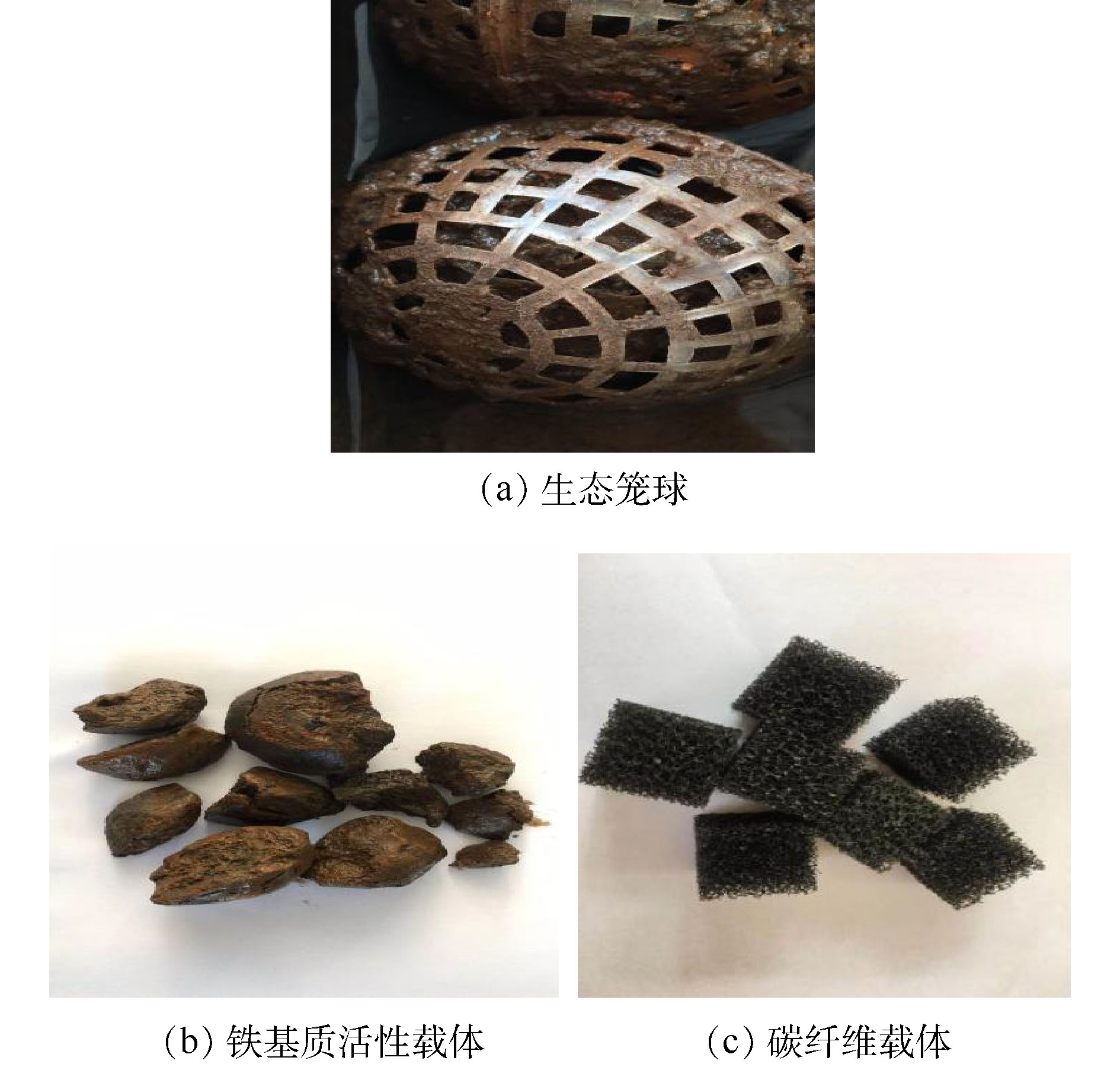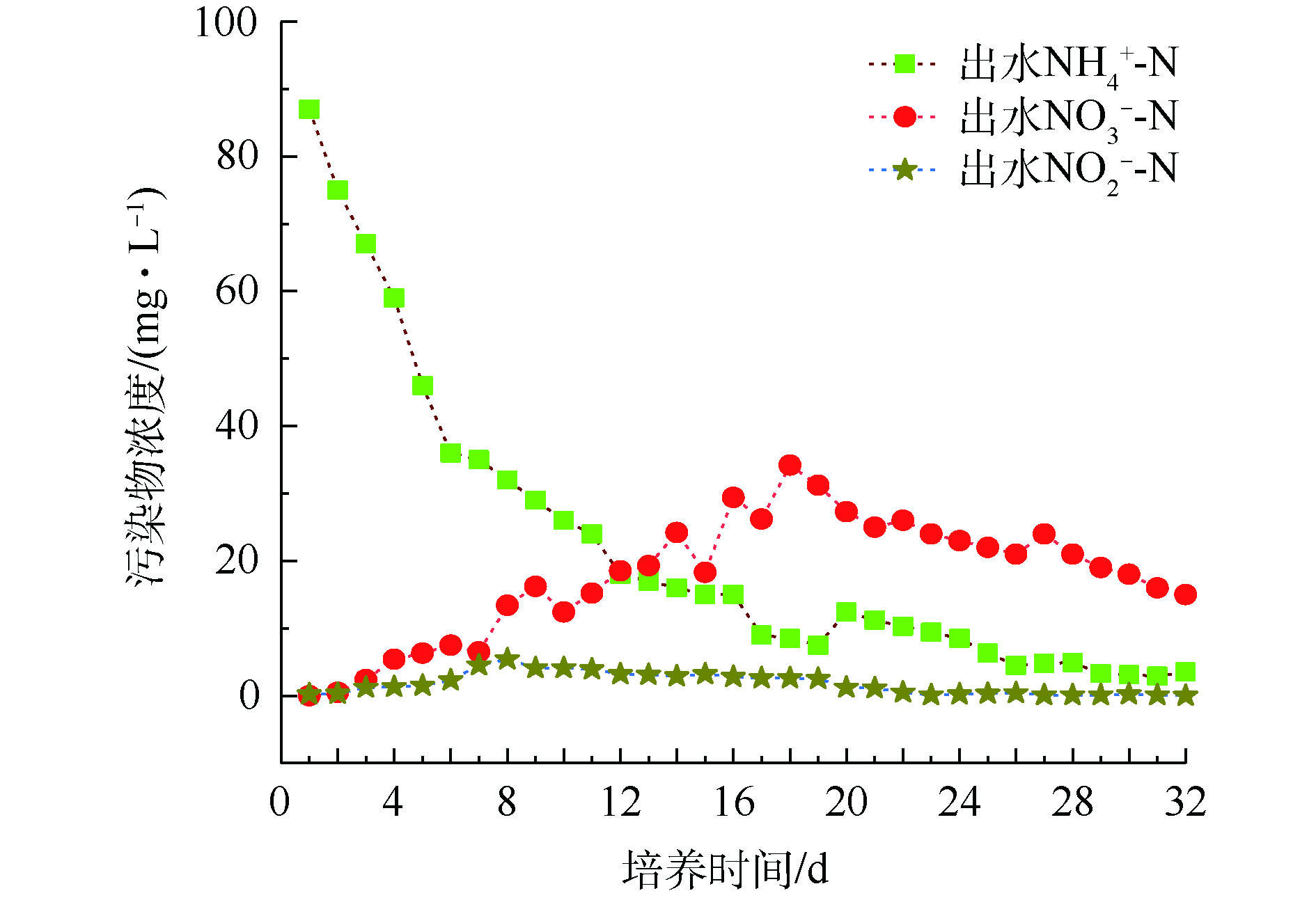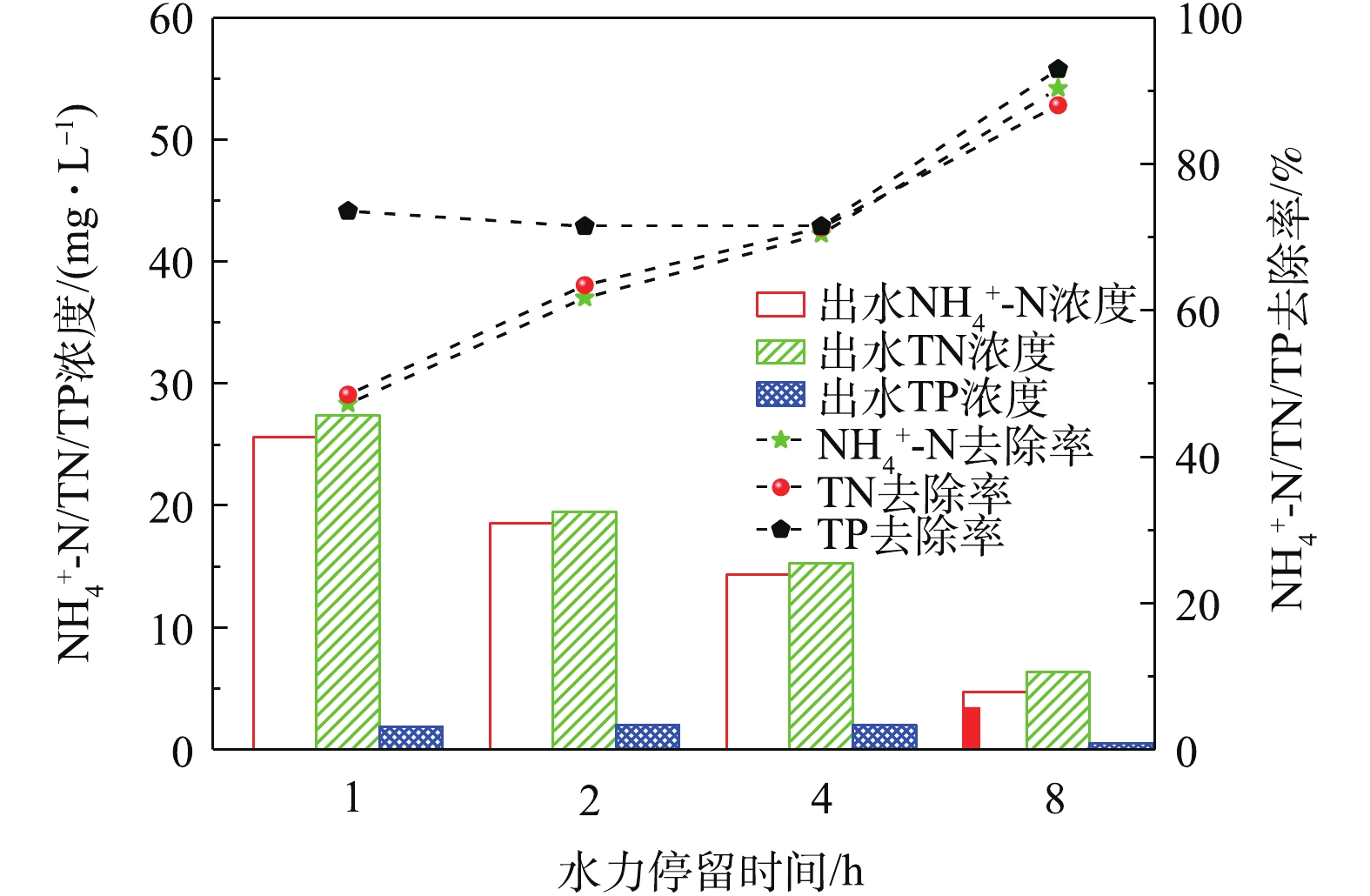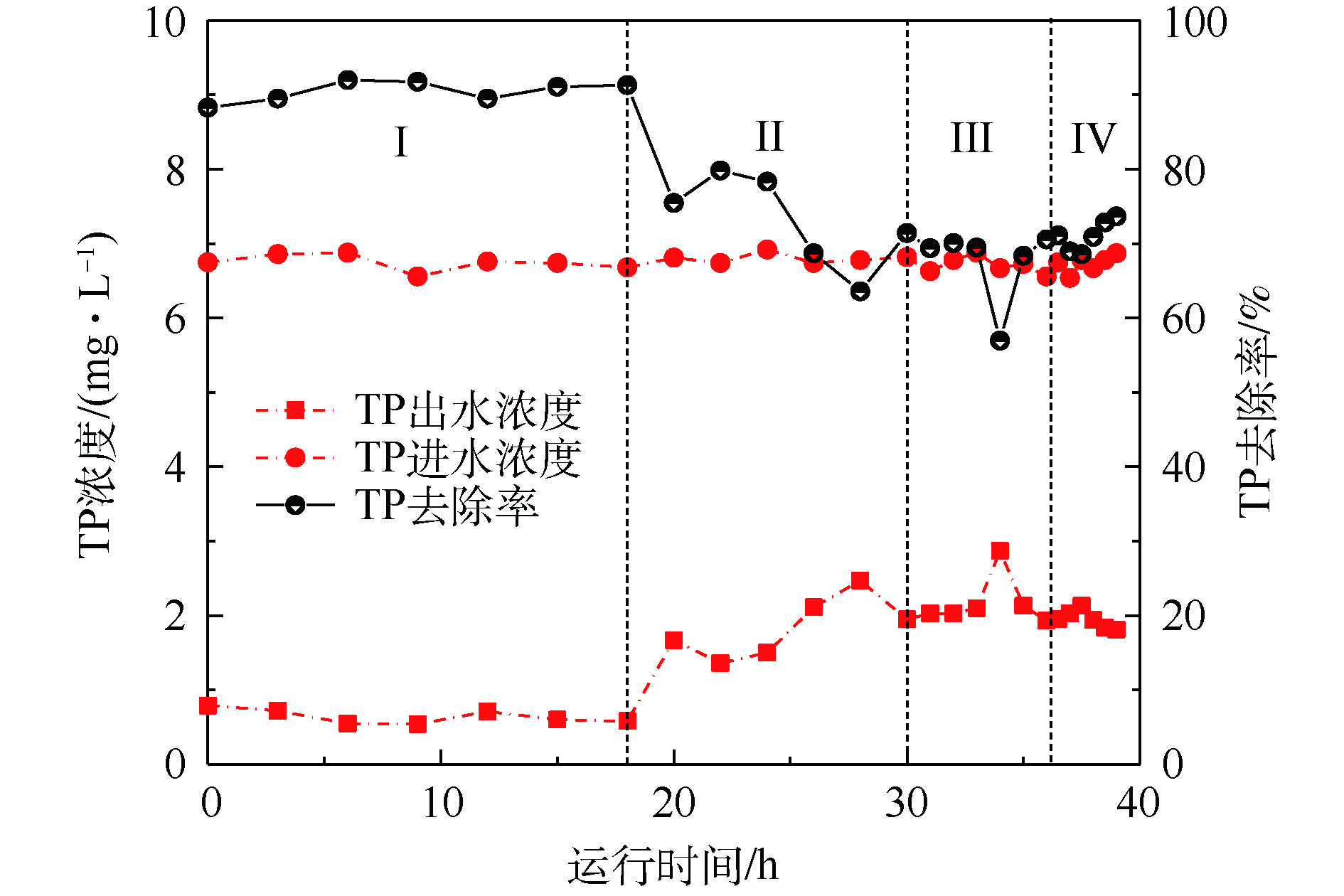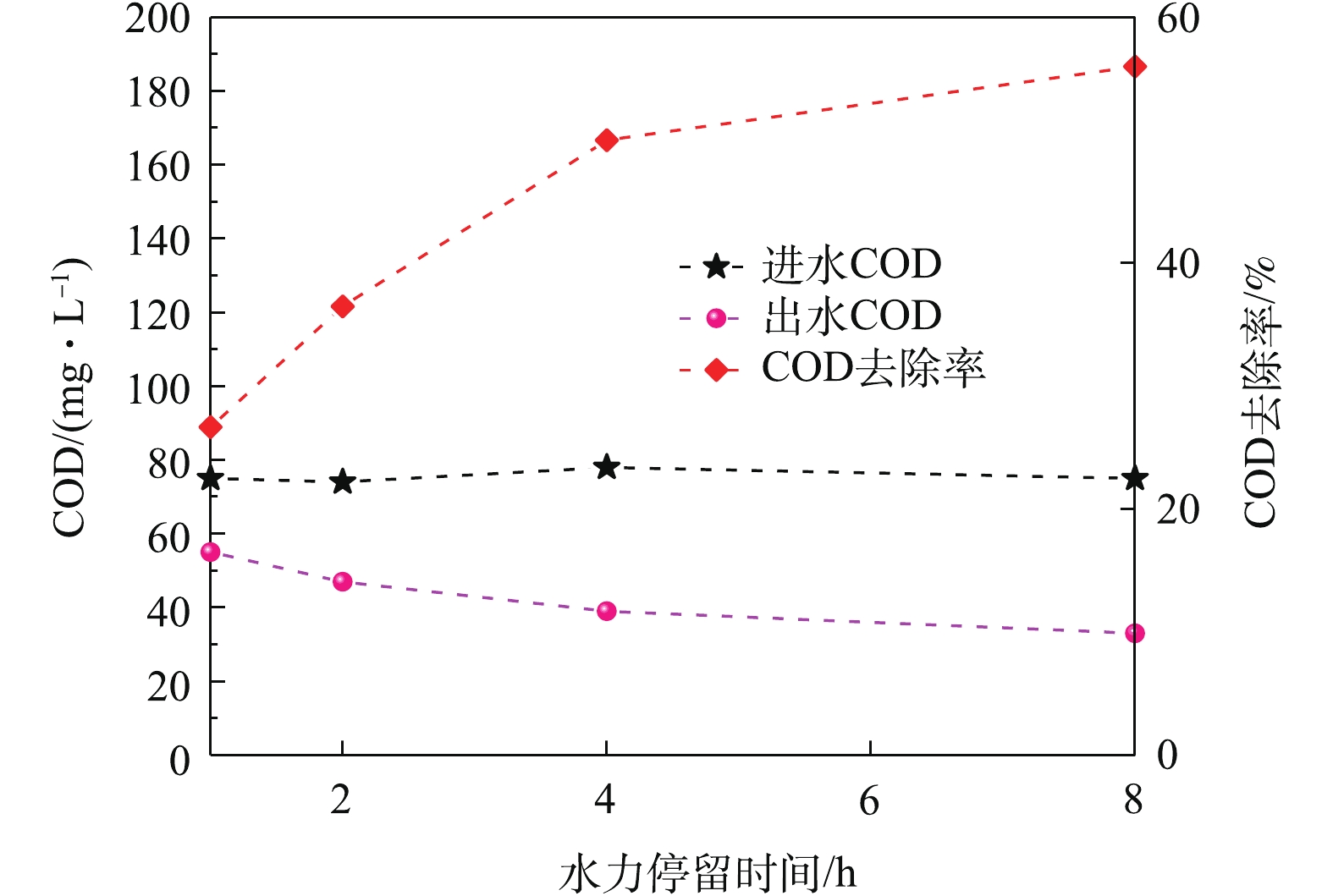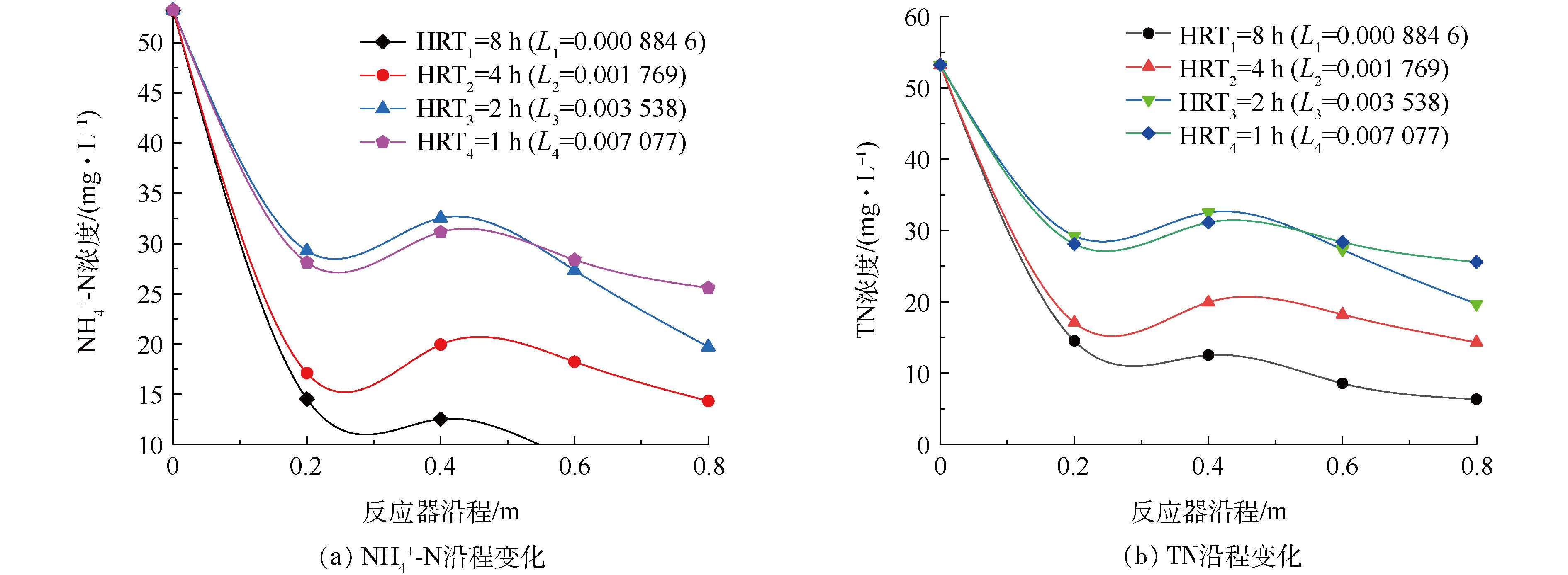-
随着城镇居民生活污水排放量的大量增加,以及污水中氮、磷等污染物浓度的不断升高,相应的处理压力亦日渐增大。污水厂排水是污水经二级生化处理后的出水,是地表水及地下水中氮、磷等污染的主要来源,其大规模集中式地排放已使污染负荷远远超过受纳水体自净能力,对受纳水体生态环境造成严重破坏[1]。目前,我国已全面启动全国城镇污水处理厂向《城镇污水处理厂污染物排放标准》一级A的提标改造[2];同时,我国在“十二五”和“十三五”规划中也明确了城镇污水处理厂排水的总氮控制目标。针对我国中小城镇污水点多、面广、量小、分散等特征,直接采用常规污水处理系统在经济和技术上均难有成效。
污水厂排水作为典型的低C/N比污水(COD/TN<(3~5)∶1),常规水处理工艺中的微生物由于缺乏有机碳源而难以进一步脱除水中的氮和磷[3]。为此,研究者开发出短程硝化反硝化(SHARON)、厌氧氨氧化(Anammox)等生物脱氮新工艺[4-5],这类工艺能高效地去除污水中的有机污染物,减少平均污水处理面积和运行人员数量,能较好地适应污水厂排水水质的波动,在实际工程中取得了一定效果。但其对温度(T)、DO、pH、游离氨(FA)、污泥龄及有毒物质、HRT的控制条件要求严格[6-7],且不适应低氮素浓度、低C/N比污水中氮的深度脱除[8-10],因此,须对现有工艺进行改良或研发新的水处理技术,以适应污水厂排水的水质特征。
针对实际工程应用中对处理工艺低成本、高效能的要求,本研究开发了一种污水化学催化生物耦合床(CCBF)技术。该技术通过铁基质载体及碳纤维载体在反应器内部形成的层次分明的好氧/微氧区,使污水始终处于好氧/微氧交替的环境中;在反应器底部,设置合理曝气量使溶解氧能够稳定输送到各微氧区,同时促进碳源在反应区内部的均匀分配,实现了电化学与生物作用耦合的运行机制下污水厂排水的深度脱氮除磷[11]。本研究重点考察了水力停留时间(HRT)对脱氮除磷效果的影响,建立了不同停留时间下的深度脱氮动力学模型,通过对反应器处理效能的实验研究、机理探讨、动力学建立及参数求解为污水厂排水深度处理提供参考。
-
本实验原水取自北京通州某污水处理厂,该水厂的处理规模为3.5×104 m3·d−1,采用脱氮除磷A2/O工艺。主要水质指标:污水厂排水水质指标:
${\rm{NH}}_4^{+} $ -N为 48.5~50.5 mg·L−1;TN为51.2~53.8 mg·L−1;TP为6.3~7.7 mg·L−1;COD为68.5~78.5 mg·L−1;pH为7.6~7.9。 -
本研究实验装置主要由进水系统、曝气系统、柱状反应器和出水系统组成,具体如图1所示。柱状反应器为有机玻璃材质,内径12 cm,高100 cm,柱体内部均匀装填铁基质生物载体和碳纤维载体,有效容积11.3 L,填充高度为90 cm,填料后水容量为4.8 L。原水经蠕动泵从反应器上部进入反应器,自上而下经过CCBF系统后,从反应器底部经三通排出。空气在空压机的作用下经反应器底部曝气沙盘进入,曝气量利用空压机出口处转子流量计调节。DO、pH、温度由WTW(上海谷雨环保科技有限公司,SenTix21型)和HANA(北京壮仕科技有限公司,Au220型)电极进行检测。
生态笼球(图2(a))是将铁基质载体与碳纤维生物活性载体有效结合的复合载体,铁基质活性载体(图2(b))直径为1~2 cm,堆积密度为1.2×103 kg·m−3,载体比表面积为3.2×104 m2·m−3,孔隙率为46%~51%,抗压强度≥600 kg·cm−2[12]。碳纤维载体(图2(c))将具有活性的碳纤维和培养基加入聚氨酯泡沫制备而成,载体整体呈方形立体分布,具有透水性好等优点[13],碳纤维生物活性载体可以起到固定微生物的作用,铁基质载体可以通过化学催化反应提供营养和电子。
-
挂膜成功后的CCBF采用全程连续进水的方式,可使反应器内有机物浓度一直维持在相对饱和的状态,使溶解氧不断被消耗,从而更有利于微生物反硝化脱氮。在适宜溶解氧浓度下,设置水利停留时间分别为8、4、2、1 h,每个水力停留时间下DO均保持5.5~6.0 mg·L−1、pH 7.6~7.9、温度22.3~22.8 ℃。为尽量避免实验间的相互干扰,加快实验进度,实验按照有机负荷从低到高的顺序分批进行,首先运行8 h实验,最后为1 h实验。每个运行周期按先后顺序又分为换水阶段和处理阶段,换水阶段主要是对反应器内原污水进行置换处理,原水与排水在反应器内部形成适当比例的耗氧分界区,经历不同时间混合后出水。处理阶段,反应器内部均为污水厂排水,经处理完全后排出。实验采用底部曝气,上进下出的进水方式,这样可使反应器内部微生物能够充分利用水体溶解氧降解污水中的有机物。
铁基质载体与碳纤维载体在反应器内部可形成相应的好氧/微氧分区,好氧区自养型硝化菌和氨氧化菌将
${\rm{NH}}_4^{+} $ -N转化为${\rm{NO}}_2^{-} $ -N、${\rm{NO}}_3^{-} $ -N[14],见式(1)。${\rm{NO}}_2^{-} $ -N、${\rm{NO}}_3^{-} $ -N进入生物膜内部与自养反硝化菌接触,刺激铁基质载体内部产生[H][15]。阳极反应见式(2)和式(3),阴极反应见式(4)。自养反硝化菌以铁基质载体生成的[H]、[Fe2+]为电子供体,将
${\rm{NO}}_2^{-} $ -N、${\rm{NO}}_3^{-} $ -N还原为N2,实现低C/N比污水厂排水深度脱氮。相关反应见式(5)和式(6),物化-生物耦合脱氮总反应式见式(7)。铁基质载体中的Fe2+在溶解氧作用下被氧化成Fe3+,Fe3+和磷酸盐结合生成磷酸铁沉淀,相关反应见式(8)、式(9)和式(10)。
-
实验过程中需要检测的污水指标及对应的检测方法参照文献中的方法[16]。采用纳氏试剂分光光度法测定氨氮(
${\rm{NH}}_4^{+} $ -N)浓度;采用重铬酸钾法测定耗氧有机污染物的浓度(以COD计);采用钼锑抗分光光度法测定总磷(TP);采用碱性过硫酸钾消解紫外分光光度法测定总氮(TN)浓度;采用WTW电极检测pH,采用YSI便携式溶解氧仪检测温度和DO。主要分析仪器为紫外-可见分光光度计(UV 2102C,美国尤尼柯仪器有限公司)、COD快速分析仪(5B-3C(V7)型,中国联华科技有限公司)、TN快速分析仪(5B-3BN(V8)型,中国联华科技有限公司)。
-
CCBF系统微生物挂膜通过接种污泥和北京交通大学东校区家属区化粪池污水培养,污泥来自北京市高碑店污水处理厂二沉池回流污泥,污水水质特征如表1所示。
在微生物驯化培养阶段,采取逐步加大曝气与进水流速的方式对微生物进行培养。首先在无曝气、无进出水的条件下对充满生活污水和污泥混合液的反应器进行静置培养(24 h),随后增大曝气量和进水流速,直至第5天,保持HRT为20 h,DO为3~4 mg·L−1,观察反应器出水情况,实验结果如图3所示。第18天,好氧反应器出水中的氨氮已经降至10 mg·L−1,同时出水硝态氮也逐渐升高至35 mg·L−1,反应器内壁及载体表面均出现黄褐色污泥生长附着。
在实验整体启动阶段,从培养微生物的第19天开始,在20 h的HRT下连续进出水运行,保持好氧反应器中的DO在3~4 mg·L−1,出水中的硝酸盐氮含量先小幅升高再逐渐下降,从培养期第29天,其浓度开始稳定在17.6~19.1 mg·L−1,出水的氨氮含量也逐渐下降,并在培养第31天以后开始稳定在3.7~5.9 mg·L−1。培养初期,存在亚硝酸盐氮升高的情况,后稳定小于0.5 mg·L−1,此时可认为反应器整体启动成功。因此,CCBF的启动共耗时31 d,此时CCBF对
${\rm{NH}}_4^{+} $ -N、TP、TN和COD的去除率分别为93.1%、86.0%、71.7%和71.9%。 -
实验按照有机负荷从低到高的顺序分批进行。当HRT为8 h时(阶段I),出水
${\rm{NH}}_4^{+} $ -N浓度由23.79 mg·L−1降至4.66 mg·L−1,这一阶段膜内微生物受到铁基质载体原电池反应微电流刺激,生长迅速,脱氮效率提高。其主要原因是:自制铁基质生物载体具有较大的比表面积,可通过性强,载体孔隙内部的活性催化物质与Fe、C形成互相协同的处理机制,在降低反应所需活化能的同时,促进了微生物系统内部的物质传递过程[17],在适宜溶解氧浓度下,增强了硝化细菌降解${\rm{NH}}_4^{+} $ -N的效能。当HRT为4 h时(阶段II),出水
${\rm{NH}}_4^{+} $ -N浓度由4.66 mg·L−1升至19.94 mg·L−1,至第2个周期运行完毕时,${\rm{NH}}_4^{+} $ -N出水浓度为14.32 mg·L−1。其原因是:当反应器处于连续运行状态时,采取较低水力负荷向高水力负荷瞬时变速的进水方式会对反应器内部微生物系统造成一定冲击,此时反应器出水水质波动较大,反应器适应进水流速的时间延长[18];同时较大的水力负荷破坏了原有的微氧/好氧分区平衡,抑制了同步硝化反硝化反应的进行,导致出水NH4+-N浓度逐渐升高。在较大有机负荷冲击下,原电池反应速率加快,电离出的活性离子加速了微生物生长,脱落的微生物膜附着在载体表面,形成溶解氧隔离层[19],使微氧/好氧各反应区分界更明显,系统整体恢复稳定后,${\rm{NH}}_4^{+} $ -N浓度开始降低。当HRT为2 h时(阶段III),
${\rm{NH}}_4^{+} $ -N出水由19.98 mg·L−1升至32.54 mg·L−1,达到了整个反应过程的峰值。有研究[20]显示,当HRT<1.5 h时,随着进水波动幅度的加大,反应器适应水力负荷的时间会逐渐延长。由图4可以看出,随着HRT的减小,水流对填料上附着微生物的冲刷作用加速了生物膜更新,导致生物膜厚度变小,不利于产生反硝化作用所需的缺氧环境[21],导致${\rm{NH}}_4^{+} $ -N浓度不断上升。从图4中每个阶段的分界点可以看出,随着HRT的减小,出水${\rm{NH}}_4^{+} $ -N浓度逐渐升高,且HRT越大,相邻2个阶段的出水浓度差越大。当HRT为8 h时(阶段I),出水TN呈线性下降趋势,与
${\rm{NH}}_4^{+} $ -N变化过程相似,浓度由23.54 mg·L−1降至6.35 mg·L−1,第1阶段末期去除率达到89%。PENG等[22]在研究硫基自养反硝化和异养反硝化过程对去除硝酸盐氮的影响时发现,HRT会在影响微生物分布和系统性能方面发挥重要作用,当HRT高于0.15 d时,反应器能更高效地去除硝酸盐和铬酸盐(超过90%)。同其他工艺(如基于硫元素的自养反硝化)相比[23],本研究利用复合活性生物载体产生的Fe-C原电池,反应保持了更高的H+或Fe2+生成率,原位H+、Fe2+的生成提供了更多有效电子供体(式(2)和式(3)),促进了微生物反硝化脱氮过程的进行(式(5)和式(6))。由图5可以看出,当HRT>8 h时,TN去除率高于89%且总体基本保持稳定。当HRT为4 h时(阶段II),TN浓度在第1运行周期上升至22.03 mg·L−1。其原因可能是:受水力负荷冲击影响反硝化作用所需的微氧系统遭到破坏,在增加了微氧区溶解氧的同时冲散了反硝化菌团,增大了反应器内悬浮物浓度。当HRT为2 h和1 h时(III、IV阶段),TN平均去除率降至65%以下,反硝化作用明显减弱,此时
${\rm{NH}}_4^{+} $ -N曲线与TN曲线基本重合,出水TN浓度随HRT的升高而降低,各水力停留时间下最佳去除率基本呈线性正相关,并且当HRT=8 h时,反应器对${\rm{NH}}_4^{+} $ -N和TN有最佳去除效果。此时,反应器内部污水与微生物有充足的接触时间,有机物含量较高,由铁碳原电池反应产生的[H]和Fe2+使反硝化菌有足够的电子供体进行反硝化脱氮。但水力停留时间过低会导致水力负荷加大,对反应器内附着微生物产生较大冲击,抑制反硝化作用的进行,${\rm{NO}}_3^{-} $ -N含量的减少导致TN去除率降低,使脱氮效果不佳。因此,CCBF实现污水厂排水深度脱氮的最佳HRT为8 h。 -
HRT对CCBF系统总磷去除效果的影响结果如图6所示。当HRT为8 h时(I阶段),出水TP由6.85 mg·L-1降至0.8 mg·L−1以下,在第2周期末,降到0.48 mg·L−1。此阶段除磷效果明显的原因可能是:受载体物化性质的影响,复合活性载体具有高比表面积,并且具有分级的微观大孔结构,当载体处于碱性介质中时,活性载体中掺杂的催化剂对氧化还原反应表现出高的电催化活性以及优异的稳定性[24]。其中,催化剂优异的电催化性能可归因于:1)协同效应,由于水体中氮、磷元素的混合,为氧化还原反应提供了更多的催化位点;2)填料中微量铁的残留极大促进了氧化还原反应;3)填料分层多孔结构产生的高表面积特性和优异的传质速率。
当HRT为4 h时(II阶段),TP出水升至2.11 mg·L−1,涨幅较大。其原因可能是:受突变的水利负荷影响,系统除磷微生物系统受到水流搅动,破坏了原有进水流速下对磷酸盐的吸收;同时,成熟的微生物膜对填料孔隙还有一定程度的堵塞,不仅抑制了填料的吸附作用,还限制了原电池反应对微生物的刺激作用。当HRT<4 h时,系统出水TP浓度产生波动式变化,新进排水与前一阶段原水混合使TP浓度有小幅上升,III阶段和IV阶段出水TP浓度分别为2.87 mg·L−1和2.13 mg·L−1,去除率均不足75%,这说明此时CCBF系统化学除磷过程受到进水流量冲击的抑制作用,停留时间的减少同样减弱了微生物对磷酸盐的富集[25]。
随着停留时间的延长,反应器内部溶解氧浓度保持稳定,Fe-C原电池产生的Fe2+被快速氧化为Fe3+,缺氧区微生物受水力负荷冲击减小,从而与Fe3+反应生成磷酸铁沉淀(式(10)),从而促进了系统除磷[26]。因此,CCBF去除污水厂排水中磷的最佳HRT为8 h。经胡智丰[27]研究验证,本系统具有长期的化学除磷效果,不用污泥回流也能实现磷的长期高效脱除。
-
当HRT为8 h(I阶段)时,如图7所示,出水COD由46 mg·L−1降至33 mg·L−1,平均去除率分别为41%和57%。与处理污水厂排水的传统脱氮工艺相比,有机污染物难以在反应器中微氧/好氧区内被消耗。这是因为污水厂排水作为沉淀池二次出水,COD/TN<1.5,作为高氨氮、低碳源的废水,其中包含了大量难降解有机物。由图7可以看出,当HRT分别为1、2、4 h,进水耗氧有机污染物的浓度(以COD计)为68.5~78.5 mg·L−1时,各水力停留时间下出水耗氧有机污染物的浓度(以COD计)分别为55.3、47、39 mg·L−1,去除率为25%~60%,出水耗氧有机污染物的浓度(以COD计)随着HRT的增加而减小。
CHEN等[28]在研究铁对三级营养素及难降解有机物的效能时发现,当有铁存在时,反应器对耗氧有机污染物的浓度(以COD计)有更好的去除效果。其原因是:铁基质的引入会使生物反应器内pH、DO浓度和生物质含量等环境条件朝着有利于污染物消除的方向发展,这意味着复合活性载体内部含有的微量铁元素与活性炭耦合机制将引导污染物经历更多样化的降解或转化途径,而HRT作为影响有机污染物去除的重要因素[29],低HRT带来高有机负荷,通过适当延长HRT,有利于微生物与可降解有机物的充分接触,可对有机污染物去除更彻底。
当HRT<4 h时,调整HRT值对COD去除增幅明显;当HRT由4 h变为8 h时,COD去除率略有上升,但基本趋于平稳。这说明低HRT下进水流量变大对反应器内微生物会造成一定冲击,使填料表面生物膜脱落,影响系统对有机物质的去除效果。因此,CCBF对污水厂排水中有机物降解的最佳HRT为8 h,结合CCBF对污水厂排水中氮、磷的降解可知,CCBF系统处理污水厂排水的最佳HRT为8 h,此时该系统对排水中氨氮、总氮、总磷和COD的去除率分别达到89.5%、85.7%、92.5%和57.9%。
-
本实验设定系统为完全推流式反应器,只存在横向的质量浓度混合,无纵向质量浓度梯度[30]。利用不同HRT下反应器中随时间变化的
${\rm{NH}}_4^{+} $ -N、TN浓度数据(运行1周期),等效替换为反应器在同比高度的延程数据(如HRT=1 h时,认为在0.5 h时出水浓度即为反应器中部延程出水),通过进水流量及反应器截面积将HRT换算成水力负荷,对系统${\rm{NH}}_4^{+} $ -N及TN降解效能进行动力学分析。经计算,HRT=8、4、2、1 h对应的水力负荷L分别为0.000 884 6、0.001 769、0.003 538、0.007 077 m3·(m2·min)−1,不同L下
${\rm{NH}}_4^{+} $ -N、TN的沿程变化如图8所示。根据Eckenfelder公式[31-32],推流式柱状反应器符合一级反应动力学,其污染物降解动力学模型见式(11)。
式中:S0为进水浓度,mg·L−1;Se为出水浓度,mg·L−1;h为反应器内填料深度,m;L为水力负荷,m3 ·(m2·min)−1;K为反应速率常数,min−1;n为与载体形状、尺寸、比表面积有关的常数。K和n的值可表征载体内微电流对微生物生长的促进作用,决定了反应器内生物量和生物活性。由式(11)可得式(12)。
式(12)为线性方程,Se/S0可由不同水力负荷下NH4+-N、TN沿程浓度变化数据求得;利用ln(Se/S0)对反应器高度h作图并拟合可求得K/Ln,结果如图9所示,拟合数据见表2。由拟合数据可知结果符合数学统计要求。
令
$\alpha = - \dfrac{K}{L^n}$ ,则$\left| \alpha \right| = - \dfrac{K}{{{L^n}}}$ ,两边取对数得式(13)。由式(13)对表2中数据进行线性回归,可得n1=0.314 76,n2=0.282 21。
根据n值求出不同水力负荷下的Ln及h/Ln的值,以ln(Se/S0)对h/Ln作图,通过拟合数据(表3)求得K值,拟合曲线如图10所示。
由表3求得不同水力负荷下反应速率常数K1、K2的平均值。K1的平均值为0.128 02,K2的平均值为0.218 59,将常数n1、n2与K1、K2带入式(11),可得式(15)和式(16)。
本研究得出的KTN=0.218 59,高于同一反应器在相同条件下的
${K_{{\rm{NH}}_4^ +{\text{-}} {\rm{N}}}} $ 。这表明CCBF系统在高曝气的条件下实现了微氧/好氧区的分界,系统内部存在同步硝化反硝化现象。nTN=0.282 21,略低于${n_{{\rm{NH}}_4^ +{\text{-}} {\rm{N}}}} $ =0.314 76。这表明该反应器中载体的理化性质适于硝化和反硝化微生物的附着和生长,脱氮系统抗氮素冲击负荷能力较强,且系统的运行(脱氮过程)不依赖于反应器对COD的降解。较大的反应速率常数K表明系统内生物量充足,且微生物代谢旺盛,从而保证了系统对污水高效、快速的降解效能。YAN等[33]发现,反应器深度、进水底物浓度、气水比和反应温度均会影响模型中参数的取值范围,反应器形式及水力负荷的不同同样会造成反应器出水底物浓度的差异。与同体积、水力负荷为0.000 8~0.007 m3·(m2·min)−1的反应器n值比较可知,本系统
${n_{{\rm{NH}}_4^ +{\text{-}} {\rm{N}}}} $ =0.314 76略高于其他同类型反应器。这说明本系统内部铁基质载体形状、尺寸、孔隙率等适于硝化和反硝化微生物附着和生长,同时较大的比表面积能增大污水与生物膜的接触面积,使污染物能更加充分地与生物膜接触,增强细菌分解功能,使其在进水污染物浓度波动时,保证出水的稳定性。 -
1) CCBF强化深度脱氮系统最佳运行参数为DO=5.5~6.0 mg·L−1、HRT=8 h、C/N=1.5∶1时,NH4+-N去除率为89.5%、TN去除率为85.7%、COD去除率为57.9%,具有良好的脱氮效率。
2) CCBF系统中的铁基质活性载体在物化-生物耦合作用下,Fe3+和磷酸盐结合,生成磷酸铁沉淀,TP去除率达到92.5%,极大地增强了CCBF的除磷功能。
3)基于Eckenfelder方程,建立了CCBF系统深度脱氮降解模型,
${\rm{NH}}_4^{+} $ -N降解模型表达式为Se(${\rm{NH}}_4^{+} $ -N)=S0(${\rm{NH}}_4^{+} $ -N)exp(−0.128 02h/L0.314 76),TN降解模型表达式Se(TN) =S0(TN)exp(−0.218 59h/L0.282 21);与水力负荷为0.000 8~0.007 m3·(m2·min)−1的常规生物处理相比,CCBF系统内部生物量充足、活性高,并实现了高曝气条件下的同步硝化反硝化,保证了系统对污水高效、快速的降解效能。
基于物化生化耦合的污水深度脱氮除磷新工艺
Mechanism of strengthened deep nitrogen and phosphorus removal from sewage based on physicochemical and biochemical coupling process
-
摘要: 为了解决常规污水处理技术无法进行完整的硝化反硝化过程,污水厂出水中氨氮、总氮、总磷偏高以及运行成本较高的问题,以某污水厂排水为研究对象,通过物化与生化耦合,构建化学催化生物耦合床(CCBF)脱氮系统,研究CCBF系统对污水厂排水中氨氮、总氮、总磷和COD的去除效能。结果表明:当DO为5.5~6.0 mg·L−1、RT为8 h、C/N为1.5∶1时,CCBF可将
${\rm{NH}}_4^{+} $ -N从48.5 mg·L−1降至4.58 mg·L−1、TN从51.2 mg·L−1降至6.5 mg·L−1、TP从6.6 mg·L−1降至0.48 mg·L−1、COD从78.5 mg·L−1降至33 mg·L−1,去除率分别达到89.5%、85.7%、92.5%和57.9%;污水经处理后,氨氮、总氮、总磷、COD均达到城镇污水处理厂污染物排放标准(GB 18918-2002)一级A排放标准。利用Eckenfelder方程对系统脱氮过程进行模拟,求得${n_{{\rm{NH}}_4^ +{\text{-}} {\rm{N}}}} $ =0.314 76,nTN=0.282 21,${K_{{\rm{NH}}_4^ +{\text{-}} {\rm{N}}}} $ =0.128 02,KTN=0.218 59,与水力负荷为0.000 8~0.007 m3·(m2·min)−1的常规生物处理相比,系统内部生物量充足、活性高,物化与生物耦合强化效果明显。Abstract: Currently, the conventional wastewater treatment plants have faced many problems such as incomplete nitrification and denitrification with conventional wastewater treatment technologies, high ammonia nitrogen, total nitrogen and total phosphorus concentrations in the effluent, and high operational cost. In this study, based on the physicochemical and biochemical coupling process, a chemical catalytic bio-coupled filter (CCBF) was constructed to treat the drainage from the wastewater treatment plant. The removal efficiencies of ammonia nitrogen, total nitrogen, total phosphorus and COD in this drainage by CCBF were studied. The results showed at DO of 5.5~6.0 mg·L−1, HRT of 8 h, C/N ratio of 1.5∶1, CCBF could reduce${\rm{NH}}_4^ + $ -N from 48.5 mg·L−1 to 4.58 mg·L-1, TN from 51.2 mg·L−1 to 6.5 mg·L−1, TP from 6.6 mg·L−1 to 0.48 mg·L−1, and COD from 78.5 mg·L−1 to 33 mg·L-1, respectively, and their removal efficiencies corresponded to 89.5%, 85.7%, 92.5% and 57.9%, respectively. The above four indictors of CCBF effluent could meet the first-class A emission level of national pollutant discharge standard of urban sewage treatment plant (GB18918-2002). The nitrogen removal process in the CCBF system was simulated by Eckenfelder equation. Reaction orders of${n_{{\rm{NH}}_4^ + {\text{-}} {\rm{N}}}} $ =0.314 76 and nTN=0.282 21, reactor rate constants of${K_{{\rm{NH}}_4^ + {\text{-}}{\rm{N}}}} $ = 0.128 02 and KTN=0.218 59, were determined with correlation coefficients (R2) of 0.983 3 for the simulation on${\rm{NH}}_4^{+} $ -N removal. In comparison with the conventional biological treatment technology at hydraulic loading of 0.000 8~0.007 m3·(m2·min)−1, the CCBF process contained high content and active biomass, and obvious physicochemical and biochemical coupling effects occurred accordingly. -

-
表 1 生活污水及处理出水水质特征
Table 1. Water quantity of domestic sewage and CCBF effluent
原水及出水 ${\rm{NH}}_4^{+} $ -N/(mg·L−1)
${\rm{NO}}_2^{-} $ -N/(mg·L−1)
${\rm{NO}}_3^{-} $ -N/(mg·L−1)
TN/(mg·L−1) TP/(mg·L−1) COD/(mg·L−1) pH 原水 47~86 <0.1 <1.8 55~102 3.5~8.6 106~267 6.90~7.85 出水 3.7~5.9 <0.5 17.6~19.1 21.5~28.8 0.3~1.2 39~75 6.76~7.95 表 2 K/Ln的拟合数据
Table 2. K/Ln fitting data
拟合对象 沿程编号 α R2 水力负荷/ (m3·(m2·min)−1) ${\rm{NH}}_4^{+} $ -N
L1 −1.461 0.855 55 0.000 884 6 L2 −1.315 61 0.749 57 0.001 769 L3 −1.055 28 0.971 1 0.003 538 L4 −0.759 86 0.912 67 0.007 077 TN L1 −1.259 01 0.776 08 0.000 884 6 L2 −1.609 68 0.798 91 0.001 769 L3 −1.998 59 0.792 13 0.003 538 L4 −2.248 45 0.882 84 0.007 077 表 3 h/Ln的拟合数据
Table 3. h/Ln fitting data table
拟合对象 沿程编号 K R2 水力负荷/(m3·(m2·min)−1) ${\rm{NH}}_4^{+} $ -N
L1 0.104 87 0.977 45 0.000 884 6 L2 0.112 26 0.958 93 0.001 769 L3 0.176 42 0.935 26 0.003 538 L4 0.118 54 0.983 33 0.007 077 TN L1 0.275 29 0.966 19 0.000 884 6 L2 0.248 78 0.916 02 0.001 769 L3 0.198 78 0.900 96 0.003 538 L4 0.151 54 0.807 59 0.007 077 -
[1] 万正芬. 城镇污水处理厂出水中氮磷高效吸附填料的筛选[D]. 青岛: 中国海洋大学, 2015. [2] 周慧, 徐得潜, 马常仁, 等. A/O-膜生物反应器工艺应用于城市污水处理厂出水提标改造的研究[J]. 环境污染与防治, 2011, 33(12): 13-17. doi: 10.3969/j.issn.1001-3865.2011.12.003 [3] 邓时海, 李德生, 卢阳阳, 等. 集成模块系统同步硝化反硝化处理低碳氮比污水的实验[J]. 中国环境科学, 2014, 34(9): 2259-2265. [4] VAN NIEL E W J, ARTS P A M, WESSELINKB J, et al. Competition between heterotrophic and autotrophic nitrifiers for ammonia in chemostat cultures[J]. FEMS Microbiology Letters, 2010, 102(2): 109-118. [5] SAYESS R R, SAIKALY P E, EL-ADEL M, et al. Reactor performance in terms of COD and nitrogen removal and bacterial community structure of a three-stage rotating bioelectrochemical contactor[J]. Water Research, 2013, 47(2): 881-894. doi: 10.1016/j.watres.2012.11.023 [6] RUIZ G, JEISON D, CHAMY R. Nitrification with high nitrite accumulation for the treatment of wastewater with high ammonia concentration[J]. Water Research, 2003, 37(6): 1371-1377. doi: 10.1016/S0043-1354(02)00475-X [7] 沙之杰, 杨勇. 短程硝化反硝化生物脱氮技术综述[J]. 西昌学院学报(自然科学版), 2008, 22(3): 61-64. doi: 10.3969/j.issn.1673-1891.2008.03.018 [8] 杨延栋, 黄京, 韩晓宇, 等. 一体式厌氧氨氧化工艺处理高氨氮污泥消化液的启动[J]. 中国环境科学, 2015, 35(4): 1082-1087. [9] 张正哲, 姬玉欣, 陈辉, 等. 厌氧氨氧化工艺的应用现状和问题[J]. 生物工程学报, 2014, 30(12): 1804-1816. [10] 户海燕, 瞿思宜, 张正哲, 等. 分子生物技术在厌氧氨氧化工艺研究中的应用[J]. 环境科学与技术, 2016, 39(1): 2620-2643. [11] 张琪, 李德生, 邓时海, 等. 基于铁碳内电解的物化-生物耦合深度脱氮[J]. 水处理技术, 2016, 42(10): 92-96. [12] 邓时海. 生物法与物化法耦合深度处理低碳氮比污水[C] //中国环境科学学会. 2016中国环境科学学会学术年会论文集: 第2卷, 2016: 2571-2580. [13] 郑炜晔. 基于铁质载体与生物耦合深度处理低C/N比生活污水的研究[D]. 北京: 北京交通大学, 2018. [14] SINTHUSITH N, TERADA A, HAHN M, et al. Identification and quantification of bacteria and archaea responsible for ammonia oxidation in different activated sludge of full-scale wastewater treatment plants[J]. Journal of Environmental Science and Health, 2015, 50(2): 169-175. [15] HOSONO T, TOKUNAGA T, KAGABU M, et al. The use of δ15N and δ18O tracers with an understanding of groundwater flow dynamics for evaluating the origins and attenuation mechanisms of nitrate pollution[J]. Water Research, 2013, 47(8): 2661-2675. doi: 10.1016/j.watres.2013.02.020 [16] 李德生, 胡倩怡, 崔玉玮, 等. 化学催化法脱除模拟地下水中硝酸盐氮[J]. 化工学报, 2015, 66(6): 2288-2294. [17] 国家环境保护总局. 水和废水监测分析方法[M]. 4版. 北京: 中国环境科学出版社, 2002. [18] 高梦佳, 王淑莹, 王衫允, 等. 脉冲式流量波动对厌氧氨氧化UASB反应器的影响[J]. 中国环境科学, 2016, 36(8): 2347-2354. doi: 10.3969/j.issn.1000-6923.2016.08.014 [19] HONG S, ZHANG J, FENG C, et al. Enhancement of nitrate removal in synthetic groundwater using wheat rice stone[J]. Water Science & Technology, 2012, 66(9): 1900. [20] LIU K, WANG H Y, MA M J, et al. Effect of temperature on denitrification of deep denitrification MBBR in municipal wastewater treatment plant[J]. Environmental Science Research, 2016, 29(6): 987-993. [21] AKUNNA J C, BIZEAU C, MOLETTA R. Denitrification in anaerobic digesters: Possibilities and influence of wastewater COD/N-NOx ratio[J]. Environmental Technology Letters, 1992, 13(9): 825-836. doi: 10.1080/09593339209385217 [22] PENG L, LIU Y, GAO S H, et al. Evaluating simultaneous chromate and nitrate reduction during microbial denitrification processes[J]. Water Research, 2016, 89: 1-8. doi: 10.1016/j.watres.2015.11.031 [23] QIAO X, PENG H, YOU C, et al. Nitrogen, phosphorus and iron doped carbon nanospheres with high surface area and hierarchical porous structure for oxygen reduction[J]. Journal of Power Sources, 2015, 288: 253-260. doi: 10.1016/j.jpowsour.2015.04.118 [24] 李楠. SBR系统在低温条件下的废水生物除磷性能及除磷途径分析[D]. 哈尔滨: 哈尔滨工业大学, 2010. [25] LI L, GAO W. Inhibition of nitrous acid on aerobic phosphorus uptake by polyphosphate bacteria[J]. Environmental Pollution Control, 2013, 35(9): 67-70. [26] FAN J, WAN X, ZHANG W. Adsorption competition of potassium ions required for biological phosphorus removal by iron phosphate precipitation[J]. Environmental Science and Technology, 2014, 4: 57-61. [27] 胡智丰. 基于特定吸附填料去除污染水体中氮和磷[C]//中国环境科学学会. 2017中国环境科学学会科学与技术年会论文集: 第2卷, 2017: 2570-2577. [28] CHEN H, LIU Y, XU X, et al. How does iron facilitate the aerated biofilter for tertiary simultaneous nutrient and refractory organics removal from real dyeing wastewater[J]. Water Research, 2019, 148(1): 344-358. [29] 陈杰云. 多级A/O+好氧生物膜组合工艺特性及处理污水效能研究[D]. 重庆: 重庆大学, 2013. [30] 高大文, 袁青, 黄晓丽, 等. 基质质量浓度对不同载体UAFB-Anammox反应器脱氮性能的影响[J]. 北京工业大学学报, 2015, 41(10): 1493-1500. doi: 10.11936/bjutxb2015040026 [31] 邓时海. 生物法与物化法耦合深度处理低碳氮比污水[C] // 中国环境科学学会. 2016中国环境科学学会学术年会论文集: 第2卷, 2016: 2571-2580. [32] WANG C R, LI J, WANG B Z, et al. Empirical model for treatment of domestic sewage by two different aerated biological filters[J]. Journal of Environmental Engineering, 2005, 6(12): 59-63. [33] YAN G, XU X, YAO L, et al. Process of inorganic nitrogen transformation and design of kinetics model in the biological aerated filter reactor[J]. Bioresource Technology, 2011, 102(7): 4628-4632. doi: 10.1016/j.biortech.2011.01.009 -











 下载:
下载:
